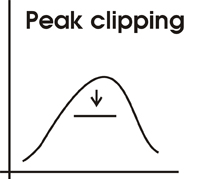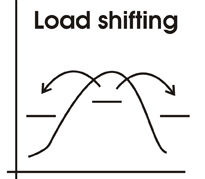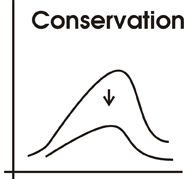
| Embedded Generation | Demand Side Management | Economic Aspects | Enviromental Aspects |
 |
|||||
|
|||||
Energy is not an end in itself; instead it is a means to provide a number of services. Businesses and households view energy as an input, an expense of doing business or maintaining a home. They are less concerned with how many kilowatt hours they purchase than with the services such as heat, light and appliances which electricity provides. This relationship provides the basis of demand-side management (DSM). DSM is defined as “The planning and implementation of strategies designed to encourage consumers to improve energy efficiency, reduce energy costs, change the time of usage or promote the use of a different energy source”, It is a partnership between the utility and customer with benefits to both [25]. DSM tries to reduce the peak load and change the shape of the load profile through the techniques of peak clipping, load shifting and energy conservation. Correctly implemented, it can reduce energy consumption with the associated financial and environmental benefits. Some strategies such as energy efficiency measures, education in energy use and technical advances in control can help with DSM. Of these strategies, energy efficiency is often the easiest to carry out. The idea behind energy efficiency is quite simple; if people consume less energy, there will be less emission of greenhouse gases as the result of the burning of fossil fuels in power stations. Energy efficiency technologies and practices can therefore play a significant role in reducing the threat of global climate change. |
||||
Energy efficiency Lighting In most homes, lighting accounts for around 10-15% of an electricity bill. In offices, the lighting may account for 25% of the electricity bill. As a result, lighting as a visible sign of energy use, is being increasingly targeted by energy efficiency measures. Over the past few years in the lighting industry, there have been advances in the development of energy efficient bulbs making them smaller and more convenient to use as direct replacements for older less efficient types. With these technological developments, lighting efficiency has improved and with it has come a reduction in energy consumption and costs. There are a number of steps that can be taken to increase lighting efficiency. The most cost effective improvements are outlined below. |
||||
|
||||
Fluorescent lamps produce illumination by passing a low intensity electric current through an inert gas, such as Argon or a mixture of Argon and Krypton. The ballast is a device mounted inside a fluorescent fixture which develops the proper voltage needed to start the flow of electricity through the gas. Once the lamp has been turned on, it then regulates the voltage in order to stabilize the output from the light. In the past, the conventional ballast was an electromagnetic design which was cheap and reliable but had several disadvantages. These included noise, light flicker and energy losses due to the induction of the coil and the development of eddy currents within the iron core. The energy losses were then dissipated as heat. It is important to take advantage of all of the light that that has been generated by the lamp. Often if high-efficiency specular reflectors are retro fitted to light fittings, there can be a reduction in the number of lamps that are used. Localised switching There should be enough switches to give flexible control in the switching of lights in an array. This increased flexibility should encourage individual lamps to be turned off if they are not required.
|
||||
Automatic control systems With some control systems being integrated into the lighting circuits, further levels of efficiency can be achieved. These lighting controls save money by controlling the time that the systems are in operation, turning them off when they are not needed. When hours-of-use decrease, a decrease in utility bills follows. The installation of one, or a combination of these systems will reduce the hours of use of the system. Occupancy sensors Ultrasonic sensors use volumetric detectors that transmit waves above the range of human hearing, then measure the time for the waves to return. Ultrasonic units can detect persons behind obstructions, but are sensitive to air movement. There are dual-technology models for use where no single type will do the job. Dual technology sensors can usually avoid difficult situations that can lead to lights being turned off when they are still required. However occupancy sensors are often blamed for reducing lamp life. The recommended ballasts for switching applications are rapid-start or program-start ballasts. A reduction in lamp life can be avoided and will usually be caused by a poor ballast choice and delay setting. When instant-start ballasts are used, lamp life can be reduced, especially with short delay settings [18]. Photoelectric sensors There are two methods of dimming a group of fixtures. One method, known as power reducing, uses either a transformer to reduce the voltage going to the ballasts or uses electronic controls to alter the waveform of the electricity but not necessarily the voltage. Both types achieve dimmed lighting and energy savings. The electronic control type is lighter and more compact, but may reduce the building's power quality as well as lamp and ballast performance. Voltage reducing is rapidly losing popularity because of new ballast technologies, but may be applicable in some circumstances. Dimming systems can provide great benefits in work areas identified with specific occupants, such as offices or classrooms, while on/off switching systems will be more appropriate for common spaces, such as hallways, warehouses and reception areas [19]. One approach for reducing energy involves designing a space to be lit with both task and ambient lighting. The ambient lighting provides overall illumination and is kept at a modest level, while brighter task lighting is provided in the local work areas. This approach uses less energy than only overall illumination and at the same time provides lighting variation in the work place, which can be visually attractive.
|
||||
|
||||
|
||||
For refrigeration and laundry appliances the Energy Efficiency Recommended logo reinforces an existing energy labelling scheme which is the European Union Energy Label . The energy labels show estimated energy consumption and give an energy grading from A to G. An A-rated appliance will use about half the electricity of a G–rated appliance. New A+ and A++ energy labels were introduced for cooling appliances during 2004. Refrigerators and Freezers The energy efficiency of refrigerators and freezers has improved dramatically over the past three decades. The refrigerator is the single biggest power consumer in many households with a typical refrigerator using between 600 and 900 kilowatt hours per year, although an efficient one will use somewhat less. Refrigerators and freezers typically make up over 20% of total domestic electricity consumptio [24]. The amount of electricity consumed will depend upon how the appliance is used and where it is located. For example, a half-full fridge or freezer uses more energy than a full one and it will also use more energy if it is placed next to a heater or oven [25]. Washing machines The standard test, which allows energy ratings to be awarded for washing machines, specifies a warm wash. This mode of operation is used because the majority of the energy used during the cycle is for heating the water. As an indicator for energy efficiency, a model that has low water consumption will save energy and water. The two main types of clothes washers are drum type machines (front loading) and agitator or impeller machines (top loading). Each has its own advantages and disadvantages, but the drum machines are usually more energy and water efficient. They manage this because their clothes drums turn on a horizontal axis and they rely on gravity for the tumbling, so no agitator is required. They also tumble the clothes through a pool of water, rather than completely immersing them in a large vertical drum as in an impeller machine. As a result of this, less water and less detergent are needed. Both types of machines use warm or cold water during the washing part of the cycle, although some efficiencies can be made as cold water is sufficient for the rinsing part of the cycle [26]. Dishwashers A relatively common assumption is that washing dishes by hand saves hot water. However, washing dishes by hand several times a day could be more expensive than operating some dishwashers. If properly used, an efficient dishwasher can consume less energy than washing dishes by hand, particularly if the dishwasher is only operated with full loads [27]. As with washing machines, the majority of energy required to run a dishwasher is used to heat the water. However most modern dishwashers come equipped with a good range of programs, including economy options, will allow you match the dishwasher's performance to your needs and helping you save energy and water [28]. Tumble dryer The use of tumble dryers varies widely, with some households using them as little as once per month while others use them to dry every load that they wash. The two main types of tumble dryers are controlled by a timer or by humidity sensors. The timer controlled dryer will operate for a preset duration, with the risk of over drying the load and wasting energy in the process. The dryer with the humidity sensor is obviously more efficient because it will finish the cycle when the load is dry, avoiding using excess electricity and causing unnecessary expense. If you are a moderate to heavy user of a tumble dryer, it may be worth considering installing a gas fired dryer. Although these types of dryers are more expensive to buy and install, they are cheaper to operate, dry clothes faster and have lower greenhouse gas emissions due to the change in fuel type. Another option is a heat pump dryer which increases its efficiency by working in a slightly different way to conventional dryers. Conventional dryers heat air, pass it over the laundry and then exhaust the hot air and moisture to the atmosphere. Heat pump dryers dehumidify the hot air after it is passed over the laundry and then recirculate the hot air back into the drum. In general conventional domestic tumble driers are not very efficient with most dryers having an energy efficient rating of C. |
||||
Insulation for energy efficiency One of the easiest and most effective energy efficient technologies available today is insulation. Overall benefits from insulation are numerous, including thermal performance, personal comfort, sound and condensation control. The thermal insulating properties of insulation materials provide important energy and environmental benefits. Made from a variety of substances including fibre-glass, mineral wool, special foams and other materials, insulation products are primarily designed to reduce the transfer of heat through building structures in residential, commercial and industrial applications [16]. By their very nature, insulation products allow consumers to achieve reductions in energy use and pollutant emissions. Over time, these reductions will amount to more than the energy required to manufacture these products. This results in a very positive overall energy and environmental balance for thermal insulation [16]. There are a number of steps that can be taken to reduce heat transfer to the surrounding environment. The most cost effective improvements are outlined below. Reducing draughts Draught proofing simply involves fitting seals around doors to stop draughts from getting into and escaping from the building carrying away heat. Draught proofing is one of the most inexpensive and effective ways of saving energy and its installation is generally within the scope of maintenance staff or householders. It may also be worth considering reducing the air-flow through any other areas such as chimneys that are not in use. Although draught reduction should be carried out to eliminate excess draughts, the rate of the air changes occurring in the space should still comply with the levels stated in the relevant building standards. Loft insulation Insulating the loft area is another easy and cheap way to make the building warmer and more energy efficient. By fitting insulating materials above the ceiling it is possible to save as much as 20% of your fuel expenses. Mineral wool or cellulose fibre in the form of mineral wool rolls are widely available and can easily be cut and shaped to fit any space within the loft. |
||||
 |
Once the loft has been insulated, reduced heat loss from the building will result in lower temperatures in the roof space. This temperature drop will then require all tanks or pipes in the loft space to be insulated to prevent any problems during freezing conditions. |
|||
Wall insulation More heat is lost through the walls of an average uninsulated house than by any other route. It is estimated that on average, 35% of the heat in a home is lost through the walls [7]. Depending upon the method of construction, there are a number of ways of insulating walls, and the most common of these is cavity wall insulation. Cavity wall insulation A cavity wall consists of an inner and outer leaf of bricks, with a small air gap in between. Most homes built since the early 1930s were constructed by this method. Cavity wall construction has excellent performance terms of weather protection and thermal efficiency when compared to a solid wall of the same thickness. The installation procedure involves filling the cavity with insulating material injected through holes drilled into the cavity, between inner and outer leaves of brickwork of the external wall. Materials commonly used for cavity wall insulation are; mineral wool fibre, polystyrene beads and urea formaldehyde foam. Cellulose fibres from shredded paper products are also gaining in popularity.
|
||||
 |
In general the installation will pay for itself after approximately 3 to 7 years and the amount of heat lost from your home through the walls will fall from approximately 35% to 10% [7]. It is more difficult for solid walls to be insulated, although it is possible to do so by fixing insulation boards to the outside or inside of the walls. To insulate the inside of a wall, one method is to use an insulating board consisting of plasterboard bonded to a layer of insulation and this is simply attached to the wall making sure that it is sealed against draughts. Another method is to attach batons to the wall and when faced with plasterboard, the space formed between the wall and plasterboard is then filled with an insulating material. To insulate the outside of a wall, a layer of mineral fibre is usually attached to the wall and a waterproof exterior cladding secured over the top of this layer. |
|||
|
||||
| Top |
||||
Techniques For customers, DSM offers a reduction in bills. From a utility perspective, DSM frees up capital for other projects and offers significant environmental benefits through the more efficient use of existing plant. It also removes the need to expand and the upgrading of the power generation and distribution network. There are three methods that are often used simultaneously to help achieve DSM on the network. These are; peak clipping which reduces the maximum daily peaks, load shifting which covers the shifting of the loads from peak periods to off-peak periods and energy conservation which aims to reduce overall demand. |
||||
Peak clipping With this approach the customers are encouraged to reduce the energy that is consumed during the peak periods during the day. Generally this will bring about the introduction of a preferential rate tariff which will discourage use through an increased charge per unit of energy consumed in this period. By offering customers a lower energy tariff if they move their appliance use away from this period, the utilities are encouraging customers to become more responsible in their energy use. Although this does not reduce the overall consumption of electricity, it can reduce the need to build new power plants, simply to serve customers during periods of peak demand. DSM can also reduce Greenhouse Gas emissions associated with using fossil fuels to meet those peak electrical demands. |
||||
 |
||||
Load shifting The aim of this method is to attempt to move demand away from the peak periods to the periods where there is a ‘valley' or a low point in the demand. This shifting of demand will help to smooth out the power supply profile and help obtain higher levels of efficiencies from the power plants by allowing a steady output instead of a load following heating regime. Once again this is primarily brought about be the use of preferential rate tariffs and other incentives offered by the power utility. |
||||
 |
||||
Energy conservation This approach simply aims to encourage more efficient ways to use energy to try to reduce the overall demand during the day. |
||||
 |
||||
Implementation of DSM and control Once the generation has been correctly sized and it has been identified that demand side control will be required, a way to implement it must be found. In order to bring about these changes in the communities demand profile there has to be some physical mechanism of controlling the loads. There are several ways to encourage consumers to shift loads within the demand profile. The first is to allow consumers to shift loads manually, so appliances are used outside times of peak demand. The utilities can encourage this by the combination of preferential rate tariffs and education about energy efficiency. The advantage of this system is that although it is cheaper to implement, it will probably have a small effect as it may not be convenient for consumers to change the time that they use their appliances. This reduction can also be difficult to sustain as people will inevitably return to their old routines after a period of time. Manual shifting is not very flexible as it is mainly targeted towards the shifting of loads from times of peak demand to low demand. In this type of scheme there is limited provision for shifting loads to take advantage of peaks in electricity generation from renewable sources. Good control over the system is necessary so that the community's load can follow the available supply. Currently there are two choices of distance switching systems; a radio tele-switching system and internet based control systems that require some connectivity to allow them to function. The radio tele-switching system controls the status of the appliances by information encoded within long wave radio frequencies [5]. A drawback of this system is that there is a long time delay between a command being given and the switching occurring. The limited amount of information that can be sent is also far from ideal. The second possibility for controlling loads is to install a system to network each home. There are systems currently on the market which can use a wireless network to connect different sensors and actuators to a central control point. There is provision for the control point to be accessed remotely with extra hardware [4]. An evolution of this network would be internet based control systems that have been developed through collaborative research carried out at University of Strathclyde [6]. These communication systems would be better suited for our applications because they will give a much better response time after switching and a far higher level of control level due to the more complex commands that can be sent via the internet. |
||||
| Top |
||||